
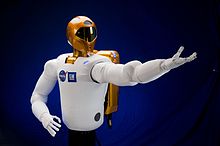
Project M was a proposed NASA project to send a Robonaut to the Moon. [1] This was originally hoped to be achieved in just a thousand days from the official announcement, but was later shifted into Project Morpheus. [2]


Project M was a proposed NASA project to send a Robonaut to the Moon. [1] This was originally hoped to be achieved in just a thousand days from the official announcement, but was later shifted into Project Morpheus. [2]
NASA projected the project could have cost less than US$200 million. An additional $250 million would have been needed for the launch vehicle. The project could have been accomplished in a thousand days or less once it had been approved. The project would have used a variation of lander developed by Armadillo Aerospace. [1] [3] On June 23, 2010, a flight carried a prototype known as the Guidance Embedded Navigator Integration Environment (GENIE). GENIE was developed to demonstrate fully functional, real-time, guidance, navigation, and control (GNC) code in a terrestrial rocket vehicle applicable to landing on the surface of the Moon. [4]
Draper Laboratory is an American non-profit research and development organization, headquartered in Cambridge, Massachusetts; its official name is The Charles Stark Draper Laboratory, Inc. The laboratory specializes in the design, development, and deployment of advanced technology solutions to problems in national security, space exploration, health care and energy.
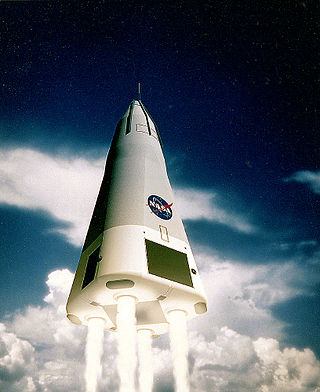
The DC-X, short for Delta Clipper or Delta Clipper Experimental, was an uncrewed prototype of a reusable single-stage-to-orbit launch vehicle built by McDonnell Douglas in conjunction with the United States Department of Defense's Strategic Defense Initiative Organization (SDIO) from 1991 to 1993. Starting 1994 until 1995, testing continued through funding of the US civil space agency NASA. In 1996, the DC-X technology was completely transferred to NASA, which upgraded the design for improved performance to create the DC-XA. After a test flight of DC-XA in 1996 resulted in a fire, the project was canceled. Despite its cancellation, the program inspired later reusable launch systems. Michael D. Griffin has since praised the program as "government R&D at its finest."

Project Gemini was the second United States human spaceflight program to fly. Conducted after the first American manned space program, Project Mercury, while the Apollo program was still in early development, Gemini was conceived in 1961 and concluded in 1966. The Gemini spacecraft carried a two-astronaut crew. Ten Gemini crews and 16 individual astronauts flew low Earth orbit (LEO) missions during 1965 and 1966.

A robonaut is a humanoid robot, part of a development project conducted by the Dexterous Robotics Laboratory at NASA's Lyndon B. Johnson Space Center (JSC) in Houston, Texas. Robonaut differs from other current space-faring robots in that, while most current space robotic systems are designed to move large objects, Robonaut's tasks require more dexterity.

A Moon landing or lunar landing is the arrival of a spacecraft on the surface of the Moon, including both crewed and robotic missions. The first human-made object to touch the Moon was Luna 2 in 1959.

A lunar lander or Moon lander is a spacecraft designed to land on the surface of the Moon. As of 2024, the Apollo Lunar Module is the only lunar lander to have ever been used in human spaceflight, completing six lunar landings from 1969 to 1972 during the United States' Apollo Program. Several robotic landers have reached the surface, and some have returned samples to Earth.
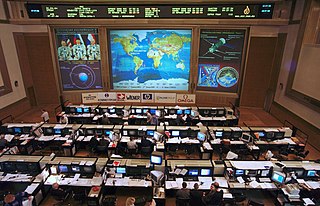
Flight controllers are personnel who aid space flight by working in such Mission Control Centers as NASA's Mission Control Center or ESA's European Space Operations Centre. Flight controllers work at computer consoles and use telemetry to monitor various technical aspects of a space mission in real-time. Each controller is an expert in a specific area and constantly communicates with additional experts in the "back room". The flight director, who leads the flight controllers, monitors the activities of a team of flight controllers, and has overall responsibility for success and safety.
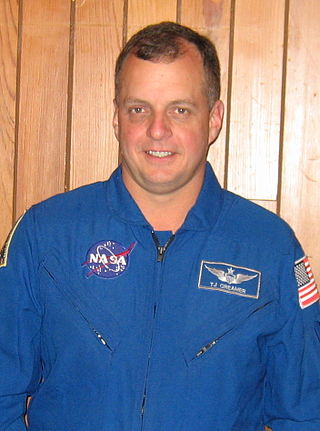
Timothy John "T. J." Creamer is a NASA flight director, retired astronaut and a colonel in the United States Army. Creamer was born in Fort Huachuca, Arizona, but considers Upper Marlboro, Maryland, to be his hometown. He is married to the former Margaret E. Hammer. They have two children.
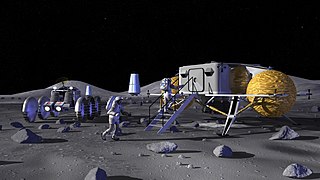
NASA proposed several concept moonbases for achieving a permanent presence of humans on the Moon since the late 1950s. Research and exploration of the Moon has been a large focus of the organization since the Apollo program. NASA's peak budget was in 1964-1965, when it comprised 4% of all federal spending in service of the Apollo Moon landing project. Though lunar landings ever since the conclusion of the Apollo program in 1972 have ceased, interest in establishing a permanent habitation on the lunar surface or beyond low Earth orbit has remained steady. Recently, renewed interest in lunar landing has led to increased funding and project planning. NASA requested an increase in the 2020 budget of $1.6 billion, in order to make another crewed mission to the Moon under the Artemis program by 2025, followed by a sustained presence on the Moon by 2028. A crew was selected for the planned crewed mission, Artemis II, in April 2023.

The idea of sending humans to Mars has been the subject of aerospace engineering and scientific studies since the late 1940s as part of the broader exploration of Mars. Long-term proposals have included sending settlers and terraforming the planet. Currently, only robotic landers and rovers have been on Mars. The farthest humans have been beyond Earth is the Moon, under the NASA's Apollo program.
In rocketry, the Armadillo Aerospace Quad vehicle called Pixel is a computer-controlled VTVL rocket that was used in 2006 to compete in the Lunar Lander Challenge.

A lunar rover or Moon rover is a space exploration vehicle designed to move across the surface of the Moon. The Apollo program's Lunar Roving Vehicle was driven on the Moon by members of three American crews, Apollo 15, 16, and 17. Other rovers have been partially or fully autonomous robots, such as the Soviet Union's Lunokhods, Chinese Yutus, Indian Pragyan, and Japan's LEVs. Five countries have had operating rovers on the Moon: the Soviet Union, the United States, China, India, and Japan.

Project Morpheus was a NASA project that began in 2010 to develop a vertical takeoff and vertical landing (VTVL) test vehicle called the Morpheus Lander. It is intended to demonstrate a new nontoxic spacecraft propellant system and an autonomous landing and hazard detection technology. The prototype planetary lander is capable of autonomous flight, including vertical takeoff and landings. The vehicles are NASA-designed robotic landers that will be able to land and take off with 1,100 pounds(500 kg) of cargo on the Moon. The prospect is an engine that runs reliably on propellants that are not only cheaper and safer here on Earth, but could also be potentially manufactured on the Moon and Mars.
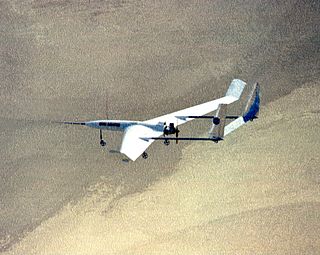
A Mars aircraft is a vehicle capable of sustaining powered flight in the atmosphere of Mars. So far, the Mars helicopter Ingenuity is the only aircraft ever to fly on Mars, completing 72 successful flights covering 17.242 km (10.714 mi) in 2 hours, 8 minutes and 48 seconds of flight time. Ingenuity operated on Mars for 1042 sols, until its rotor blades, possibly all four, were damaged, causing NASA to retire the craft.

The SpaceX Red Dragon was a 2011–2017 concept for using an uncrewed modified SpaceX Dragon 2 for low-cost Mars lander missions to be launched using Falcon Heavy rockets.
The (Japanese) Lunar Exploration Program is a program of robotic and human missions to the Moon undertaken by the Japanese Aerospace Exploration Agency (JAXA) and its division, the Institute of Space and Astronautical Science (ISAS). It is also one of the three major enterprises of the JAXA Space Exploration Center (JSPEC). The main goal of the program is "to elucidate the origin and evolution of the Moon and utilize the Moon in the future".
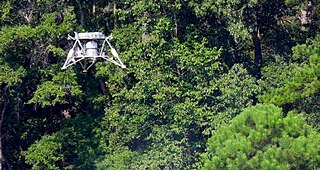
The Mighty Eagle is a prototype robotic lander developed by NASA at the Marshall Space Flight Center in Huntsville, Alabama.
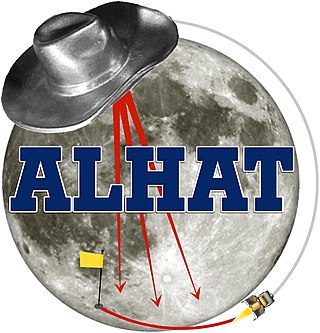
Autonomous Landing Hazard Avoidance Technology (ALHAT) is technology NASA is developing to autonomously land spacecraft on the Moon, Mars or even an asteroid.

SpaceIL is an Israeli organization, established in 2011, that competed in the Google Lunar X Prize (GLXP) contest to land a spacecraft on the Moon.
Matthew Ondler is the CTO and Director of Spacecraft Development at Axiom Space. Axiom Space is building the world's first commercial space station. Shortly after Ondler joining Axiom Space, NASA announced the award of $140M contract to Axiom and the exclusive right for Axiom Space to build its space station off the forward port of the ISS. Previously he was the president and co-founder of Houston Mechatronics. Before that, he was the lead manager of the software, robotics, and simulation division of NASA's Johnson Space Center. Ondler earned his BS in Aerospace Engineering from the University of Colorado in Boulder, CO. He then moved to Houston, TX, where he began a 28 year career at NASA Johnson Space Center. While at NASA he achieved his MBA in Finance and Marketing from the University of Houston and completed the Senior Executive Fellows Program at Harvard University.
The idea, known as Project M, is almost a guerrilla effort within NASA, cooked up a year ago by Stephen J. Altemus, the chief engineer at Johnson. He tapped into discretionary money, pulled in engineers to work on it part time, and horse-traded with companies and other NASA units to undertake preliminary planning and tests.
Project Morpheus started out as "Project M," a concept that called for landing a humanoid robot on the moon in 1,000 days. Then reality set in, and the project was redefined.